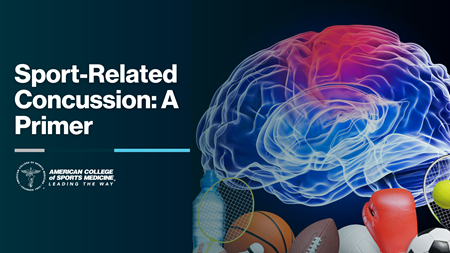Joe Sherlock, ACSM Copywriter |
Oct.
28, 2022
 So, you’ve had yourself a concussion. Or maybe a client or one of your athletes has. And now you’re wondering what exactly happened, medically speaking, and when you or your client will be healed up and able to get back in the swing of things.
So, you’ve had yourself a concussion. Or maybe a client or one of your athletes has. And now you’re wondering what exactly happened, medically speaking, and when you or your client will be healed up and able to get back in the swing of things.
Fortunately, ACSM’s Team Physician Consensus Conference (TPCC) has updated guidelines, published in Current Sports Medicine Reports, on this exact subject. Let’s explore:
First, we should define our terms. The TPCC guidelines focus on sport-related concussion, or “SRC,” so I’ll be considering that condition — rather than concussion more broadly — in this post. According to the experts, an SRC is actually a traumatic brain injury. It’s caused by physical forces affecting the brain, sometimes directly and sometimes indirectly. So, a hefty bonk on the head could cause an SRC, but so could a blow to another part of the body with enough force behind it to also act on the head — say a quick directional change, like being on the receiving end of a particularly brutal or unlucky tackle in a football game.
But getting a diagnosis can be tricky. We don’t yet have reliable SRC biomarkers — though researchers are working on that — and the way physicians come to a conclusion about whether someone has had an SRC is by weighing a number of symptoms and factors, like neurological issues that develop suddenly and dissipate relatively quickly and a lack of other potential contributors like drugs, alcohol or spinal injury. Also note that you don’t have to have lost consciousness to have experienced an SRC, and your CT and MRI scans, if you get them, will likely look completely normal. Not exactly helpful.
But now your physician has ultimately diagnosed you with an SRC, and you’re wondering how long you’ll be experiencing symptoms, which up to this point might have consisted of headache, dizziness, confusion and feeling like you’re in a fog. You might also be anxious — understandably — and irritable, or you might be having trouble sleeping — or not sleeping. Lovely.
The good news is that the majority of adult athletes typically recover from SRC within two weeks. For children it can be a little longer, normally up to four weeks. If symptoms persist beyond that timeframe, you could say you’re experiencing “persisting symptoms after SRC,” which the TPCC physicians shorten to the initialism “PSaSRC.”
The reasons behind PSaSRC are complex, but some of the factors associated with a longer recovery include experiencing a higher number of initial symptoms, having a preexisting mood disorder such as anxiety or depression, or resting too long after the injury.
That last point is perhaps the most interesting. For some time, the conventional wisdom was to employ rather extreme rest, both physical and mental, after an SCR. And though there’s still value in spending the first 24-48 hours at rest to adequately heal and recover, whiling away more than a few days in bed or on the couch might actually be counterproductive. Speak with your doctor, of course, but the latest findings seem to indicate it’s best not to stay under strict rest for too long but instead, as the TPCC physicians put it, “gradually and progressively resume cognitive and physical activity.”
To sum things up: An SRC is a sport-related traumatic brain injury caused by direct or indirect forces on the head. SRCs can be difficult to diagnose, but if a physician determines you’ve experienced one, you can expect to be dealing with symptoms for about two weeks (four weeks for children). Any longer than that, and you’re — logically — experiencing persistent symptoms. Though there isn’t an easy way to determine who will have persistent symptoms and who won’t, a good proactive measure against them is to, with your doctor’s guidance, slowly return to activities of daily living rather than following the older model of strict rest, which may actually lengthen your recovery.
Good luck, and — cautiously and judiciously — get back out there.